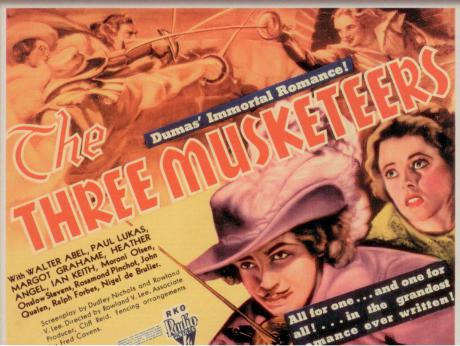
RKO Radio, 1935. Director: Rowland V. Lee. Screenplay: Dudley Nichols and Rowland V. Lee, based on the novel by Alexandre Dumas, père. Camera: Peverell Marley. Film editor: George Hively. Music: Max Steiner. Cast: Walter Abel, Paul Lukas, Margot Grahame, Heather Angel, Ian Keith, Moroni Olsen, Onslow Stevens, Rosamond Pinchot, John Qualen, Ralph Forbes, Nigel de Brulier.
I became interested in this film while researching it for a project involving the Max Steiner score. This 1935 version of The Three Musketeers has existed under a cloud ever since its original release, held in low esteem because it failed to measure up to the silent Douglas Fairbanks version of 1921. As I’ve written elsewhere, I don’t disagree with that assessment—but I do think it’s a little unfair, since no other film version of Three Musketeers has ever measured up to the Fairbanks classic.
In any case—and this will likely become a consistent theme in this department—every film deserves to be judged on its own terms. And judged on its own terms, this Three Musketeers is a thoroughly enjoyable little picture, packed from beginning to end with action, court intrigue, and a rollicking sense of adventure. Its scenes of swordplay are top-notch, bearing the stamp of fencing master Fred Cavens (fencing consultant to Fairbanks, Errol Flynn, and other swashbuckling stars in between). And it concludes with a rousing chase scene staged by second-unit director Otto Brower, a full reel of exciting action that should leave any viewer satisfied.
RKO announced this production as early as May 1934, originally intending the starring role of D’Artagnan as a vehicle for imported Czech actor Francis Lederer. Lederer’s heavy accent proved a problem, and the studio considered other actors, including Brian Aherne, before assigning the role to stage newcomer Walter Abel. He makes an earnest, likable D’Artagnan, entering into the action scenes with gusto. His youth and ready smile are real assets in this role, and it’s probably not a coincidence that he sports a thin Fairbanksian mustache!
And the cast also includes other names of interest. My fellow Disney enthusiasts will probably take a special interest in another stage import, Moroni Olsen, making his film debut as a towering, robust Porthos. He would go on to a variety of other movie roles, including the voice of the magic mirror in Snow White and the Seven Dwarfs! Nigel de Brulier appears as Cardinal Richelieu, a role that was evidently a specialty for him; he had played the same character in the 1921 Fairbanks version of Three Musketeers, and in the sequel, The Iron Mask, in 1929. Another notable cast member, taking an experimental stab at movie acting, is Rosamond Pinchot as Queen Anne. Rosamond was the daughter of Gifford Pinchot, the former governor of Pennsylvania, who had aggressively championed Prohibition during the 1920s. She offers a creditable performance for a beginner, but of course is overshadowed by Heather Angel as a lovely, spirited Constance, and especially by Margot Grahame as a delightfully evil Lady de Winter—seductive, cunning, and ruthless.
I’m always fascinated by the adroitness with which Hollywood filmmakers were able to cobble together disparate locations to create, on the screen, the convincing illusion of a make-believe setting—in this case, seventeenth-century France. Here, RKO’s sound stages and standing sets were supplemented by the RKO Ranch, the “Pathé 40” property adjoining the RKO-Pathé lot, and, during one of the chase scenes, the Upper Franklin County Reservoir. The pigeon loft that houses Count de Rochefort’s carrier pigeons was built on the property of C.P. Walaschek, a Hollywood bird trainer who also supplied and trained the pigeons. And Luxembourg Park, where D’Artagnan and the Musketeers defy the Cardinal’s ban on dueling, was actually the estate of Earle C. Anthony, a successful Packard dealer in Hollywood, who allowed the filmmakers to use his property on the sole condition that they make a donation to Children’s Hospital of Los Angeles.
And then there’s that musical score! By 1935 Steiner was a past master at constructing a score so as to subtly enrich and enhance the mood and action of a film, without ever getting in the way. His Musketeers score is a case in point, undergirding the narrative at every turn, reinforcing the viewer’s empathy with the characters and intensifying our suspense as to whether the Queen’s diamonds will be recovered in time to save her from disgrace. Then, during those closing reels, Steiner pulls out all the stops, driving the desperate race back to Paris and the final confrontation at the palace with a wave of unstoppable, pulse-pounding music that multiplies the excitement, and renders the happy ending doubly satisfying. The Three Musketeers currently doesn’t seem to be available on DVD, but it does occasionally turn up on TCM. When it does, it’s worth another look, a solid, professionally produced, and thoroughly entertaining movie take on the Dumas classic.

